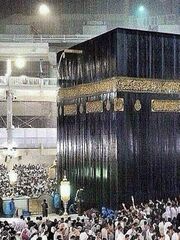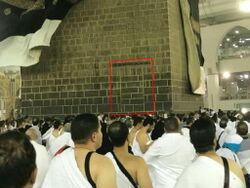Ka'ba: Difference between revisions
No edit summary |
Pourghorbani (talk | contribs) No edit summary |
||
| (4 intermediate revisions by one other user not shown) | |||
| Line 9: | Line 9: | ||
==Al-Hajar al-Aswad (The Black Stone)== | ==Al-Hajar al-Aswad (The Black Stone)== | ||
{{Main|al-Hajar al-Aswad}} | |||
Al-Hajar al-Aswad (the Black Stone), located in the eastern corner in an approximate height of 1.5 meter, is a black reddish, oval stone with red spots on it with a diameter of 30 centimeters framed in a silver casing. | Al-Hajar al-Aswad (the Black Stone), located in the eastern corner in an approximate height of 1.5 meter, is a black reddish, oval stone with red spots on it with a diameter of 30 centimeters framed in a silver casing. | ||
| Line 27: | Line 28: | ||
==Kiswa== | ==Kiswa== | ||
Kaʿba is covered by a black curtain called Kiswa or Kaʿba Curtain. It is said that Tubbaʿ al-Ḥimyarī, a king of Yemen, was the first who covered Kaʿba with curtain. The tradition was continued afterwards. Imam 'Ali (a) also sent curtains for Kaʿba from Iraq every year during his reign. When al-Mahdi al-'Abbasi became caliph, the servants of Ka’ba complained him about; the huge amount of curtains on Kaʿba may damage the House. Al-Mahdi ordered to remove all curtains except one, and to replace that every year. This tradition has continued till today and since then every year the kiswa is replaced with a new one, crocheted with verses of the Holy Quran. | Kaʿba is covered by a black curtain called Kiswa or Kaʿba Curtain. It is said that Tubbaʿ al-Ḥimyarī, a king of Yemen, was the first who covered Kaʿba with curtain. The tradition was continued afterwards. Imam 'Ali (a) also sent curtains for Kaʿba from Iraq every year during his reign. When al-Mahdi al-'Abbasi became caliph, the servants of Ka’ba complained him about; the huge amount of curtains on Kaʿba may damage the House. Al-Mahdi ordered to remove all curtains except one, and to replace that every year. This tradition has continued till today and since then every year the kiswa is replaced with a new one, crocheted with verses of the Holy Quran. | ||
==References== | |||
{{ref}} | |||
* Makkah and Madinah: The Cities of Bounties & Blessings, Hajj and Ziarah Research Center | |||
{{end}} | |||
[[Category:Completed articles]] | |||
[[Category:Al-Masjid al-Haram]] | |||
[[fa:کعبه]] | |||
Latest revision as of 17:27, 1 September 2023

Kaʿba is a roofed, squared building inside al-Masjid al-Haram, with its walls built from grayish stones. Throughout the year, this building is covered with a black curtain with its top margin crocheted with golden strings. Height of Kaʿba is approximately 15 meters. The dimensions of Ka'ba are, the door side i.e. from al-Rukn al-Aswad to al-Rukn al-Iraqi 11.68 meters, from al-Rukn al-Iraqi to al-Rukn al-Shāmī where Hijr Ismaʿil stands 9.90 meters, from al-Rukn al-Shāmī to al-Rukn al-Yamanī 12.4 meters and from al-Rukn al-Yamanī to al-Rukn al-Aswad 10.18 meters.
Gate
The gate of the House is located in its eastern side and stands two meters high above the ground. It is closed during the year, and opens only when they want to wash the House from inside or when there is any high ranking visitor from Islamic countries.
Corners
Each of the four corners (rukn) of the House has a special name, as: al-Rukn al-Iraqi (the corner toward Iraq) for the northern, al-Rukn al-Shāmī (the corner toward Syria) for the western, al-Rukn al-Yamanī (the corner toward Yemen) for the southern, and al-Rukn al-Aswad (the corner in which al-Hajar al-Aswad is placed) for the eastern corner. During 1996 CE reconstruction activities, its internal walls were repaired and new stones were incorporated on them.
Al-Hajar al-Aswad (The Black Stone)
Al-Hajar al-Aswad (the Black Stone), located in the eastern corner in an approximate height of 1.5 meter, is a black reddish, oval stone with red spots on it with a diameter of 30 centimeters framed in a silver casing.

Waterspout
The Waterspout is located on the roof of the Kaʿba, between al-Rukn al-Iraqi and al-Rukn al-Shāmī, above Hijr Isma’il. It is said that it was first installed by al-Hajjaj b. Yusuf to prevent concentration of rainwater on the roof. According to traditions, prayers under the waterspout of Kaʿba are granted.
Multazam
The part of the House wall between al-Rukn al-Aswad and the gate of Kaʿba is called Multazam owing to the pilgrims feel bound to pray at this point.

Mustajar
Mustajar is located beside al-Rukna al-Yamani and opposite to the gate while at the times when Kaʿba had two gates, its other gate was located at this place, which was removed later. It is said that this part of Kaʿba wall was split for Fatimah-bint-Asad to give birth to Imam Ali (a.s) who is thus called the Infant of Kaʿba.
Shadharwan
A small protrusion around Kaʿba wall, except Hijr Isma’il wing, is called Shadharwan.
Kiswa
Kaʿba is covered by a black curtain called Kiswa or Kaʿba Curtain. It is said that Tubbaʿ al-Ḥimyarī, a king of Yemen, was the first who covered Kaʿba with curtain. The tradition was continued afterwards. Imam 'Ali (a) also sent curtains for Kaʿba from Iraq every year during his reign. When al-Mahdi al-'Abbasi became caliph, the servants of Ka’ba complained him about; the huge amount of curtains on Kaʿba may damage the House. Al-Mahdi ordered to remove all curtains except one, and to replace that every year. This tradition has continued till today and since then every year the kiswa is replaced with a new one, crocheted with verses of the Holy Quran.
References
- Makkah and Madinah: The Cities of Bounties & Blessings, Hajj and Ziarah Research Center